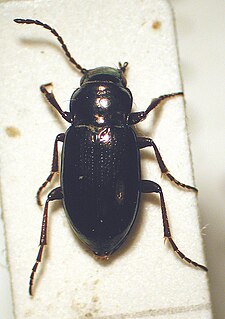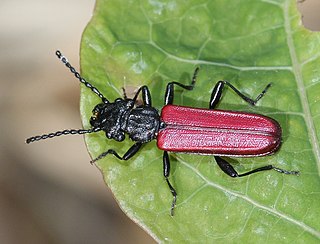
Passalidae is a family of beetles known variously as "bessbugs", "bess beetles", "betsy beetles" or "horned passalus beetles". Nearly all of the 500-odd species are tropical; species found in North America are notable for their size, ranging from 20–43 mm, for having a single "horn" on the head, and for a form of social behavior unusual among beetles.

The rove beetles are a family (Staphylinidae) of beetles, primarily distinguished by their short elytra that typically leave more than half of their abdominal segments exposed. With roughly 63,000 species in thousands of genera, the group is currently recognized as the largest extant family of organisms. It is an ancient group, with fossilized rove beetles known from the Triassic, 200 million years ago, and possibly even earlier if the genus Leehermania proves to be a member of this family. They are an ecologically and morphologically diverse group of beetles, and commonly encountered in terrestrial ecosystems.
Lutrochidae is a family of water beetles sometimes known as "travertine beetles", since in North America they are common in springs and streams depositing travertine.

The Trachypachidae are a family of beetles that generally resemble small ground beetles, but that are distinguished by the large coxae of their rearmost legs. There are only six known extant species in the family, with four species of Trachypachus found in northern Eurasia and northern North America, and two species of Systolosoma in Chile. They were much more diverse in the past, with many members belonging to the extinct subfamily Eodromeinae, the first fossils known of this family are of the genera Petrodromeus and Permunda from the Permian-Triassic boundary of Russia.

Sphaerites is a genus of beetles, the only genus in the family Sphaeritidae, sometimes called the false clown beetles. It is closely related to the clown beetles but with distinct characteristics. There are five known species, widespread in temperate area but not commonly seen.

The Cucujidae, "flat bark beetles," are a family of distinctively flat beetles found worldwide under the bark of dead trees. The family has received considerable taxonomic attention in recent years and now consists of 59 species distributed in four genera.

Derodontidae is a family of beetles, in its own superfamily, Derodontoidea, sometimes known as the tooth-necked fungus beetles. Beetles of this family are small, between 2 and 6 mm in length, with spiny margins on their pronotum that give them their name. The genus, Laricobius, lacks these spines. They have two ocelli on the top of their heads.
The family Archeocrypticidae is a small group of beetles with no vernacular common name, though recent authors have coined the name cryptic fungus beetles. Adults and larvae seems to be saprophagous and are often found in plant litter. Worldwide, about 10 genera and 50 species are found, most species are pantropical. Enneboeus caseyi has been recorded from the American South, Central America, and Mexico. About 20 species are found in Australia, in the genera Enneboeus and Australenneboeus.

The Boridae are a small family of beetles with no vernacular common name, though recent authors have coined the name conifer bark beetles.
Syntelia is a genus of middle-sized beetles, the only genus in the family Synteliidae.

Melyridae are a family of beetles of the superfamily Cleroidea.
Hygrobia is a genus of aquatic beetles native to Europe, North Africa, China and Australia. It is the only genus in the family Hygrobiidae, also known as the Paelobiidae. These are known commonly as squeak beetles or screech-beetles.

Jacobsoniidae is a family of beetles. The larvae and adults live under bark, in plant litter, fungi, bat guano and rotten wood. It is a small family with 23 described species in three genera:

Phycosecidae is a small family of beetles, in the suborder Polyphaga. The species are small, about 1.5–3.5 mm in length. It contains the single genus Phycosecis with the following species:

Silvanidae, "silvan flat bark beetles", is a family of beetles in the superfamily Cucujoidea, consisting of 58 described genera and about 500 described species. The family is represented on all continents except Antarctica, and is most diverse at both the generic and species levels in the Old World tropics.

Byturidae, also known as Fruitworms, is a very small family of beetles, in the suborder Polyphaga, comprising fewer than 20 species worldwide. The larvae of some species develop in fruits. Byturus unicolor affects species of Rubus and Geum.
The Brachypsectridae are a family of beetles commonly known as the Texas beetles. There is only one genus, Brachypsectra. The type species, Brachypsectra fulva, occurs in North America. There are three other species which occur in southern India, Singapore and northwestern Australia. Two other extant and fossil species have been described from the Dominican Republic.

Clambidae is a family of beetles. They are known commonly as the minute beetles or the fringe-winged beetles. They are found worldwide on every continent except Antarctica.
Digonophorus elegans is a species of beetles belonging to the family Lucanidae. It is found in India.

Cyclaxyra is a genus of cucujoid beetles in the family Cyclaxyridae. There are two described species in Cyclaxyra, found on the North Island, South Island, and Stewart Island of New Zealand.














